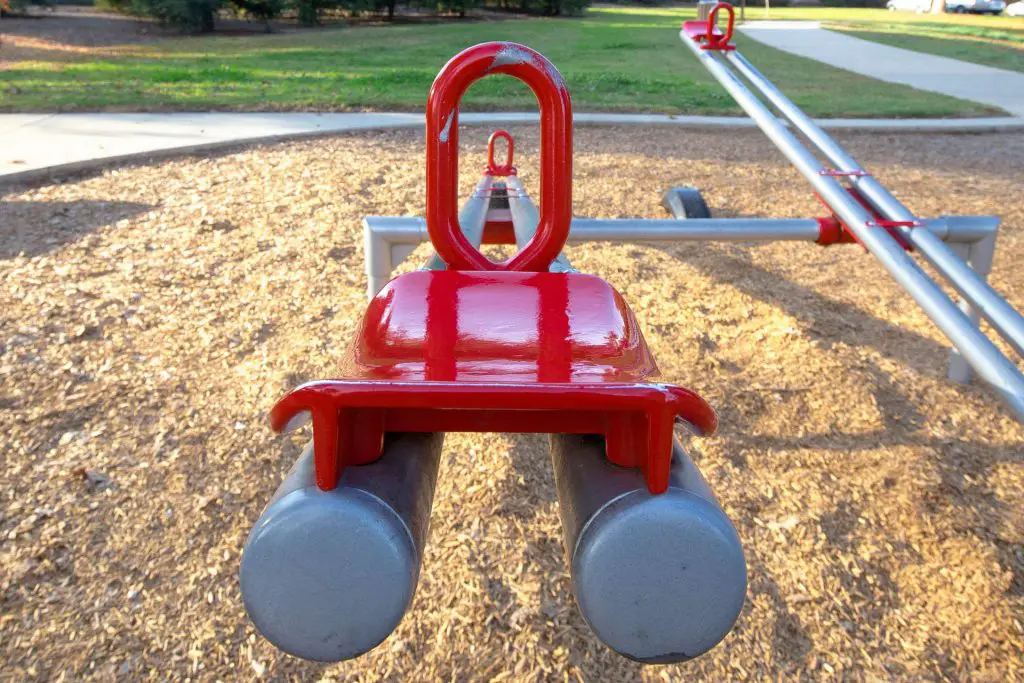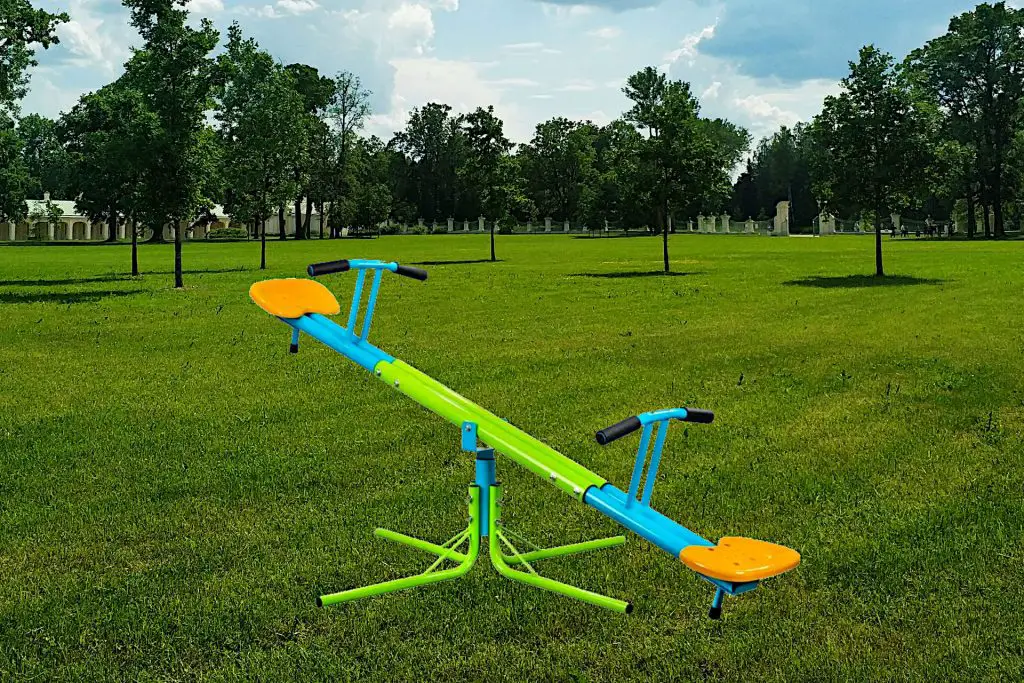Teeter Totter vs Seesaw – Is There a Difference?
When it comes to playground equipment for your backyard, two of the most popular choices are the teeter-totter and seesaw. But what’s the difference? And which one is better for your child?
Both pieces of equipment have their own unique benefits that can make them great additions to any playground. But they provide more than just fun, they are a great form of exercise for small young children and cause them to intuitively learn some of the basic laws of physics. Keep reading to learn more about the key differences between teeter totters and seesaws.
A teeter-totter and seesaw are similar backyard toys. A seesaw is a garden toy that consists of two seats that move up and down, whilst a teeter-totter consists of two or more seats that move in a side-to-side direction as well as up and down. You will sometimes find that in certain parts of the world both toys are conflated under the ‘teeter-totter’ name despite their differences.
Seesaws, Teeter Totters, and The Basic Laws of Physics
Although both seesaws and teeter-totters appear simple toys there is actually some very interesting physics that is utilized in making them work. What is more, in using them, children get to intuitively learn some of the basic laws of physics.
The Greek mathematician Archimedes (287-211 BCE) once said “give me a place to stand and I shall move the earth”! This statement was the basis of Archimedes’s mathematical formula for the leaver. With this formula, he proved the relationship between resistance force and distance, which is the principle upon which both the seesaw and teeter-totter work.
What is Torque?

Torque is the rotational force that produces a turning motion. It is measured in terms of the force it takes to rotate an object a certain number of degrees. This rotational force is what makes objects such as seesaws and teeter-totters move.
The more torque an object has, the more it will rotate. Torque is measured in terms of how many inches a full turn of the object requires to produce the same amount of torque. This measurement is called Angular Torque (in).
A simple seesaw can be used to show how torque works. The two sides of a plank of wood in a seesaw move up and down because they are pivoted on a fulcrum. The force needed to lift the side depends on how heavy it is and how far away from the fulcrum it is. An object on the end of the plank is said to be considered as having a moment of inertia. In other words, how much the object is going to resist being moved upwards.
If this is applied to the seesaw, the fulcrum will try to remain at rest, i.e. in equilibrium when the torque applied to the ‘effort side’, multiplied by the distance from the fulcrum point, equals the weight that it is trying to lift on the resistance side, multiplied by its distance from the fulcrum. Thus, an inverse relationship exists between the two sides.
In practice, this means that if you are playing with a heavier child you would have to either produce more force through your legs or lean back further in your seat, or perhaps a combination of both, to lift up the child on the other end. By doing this, they are inadvertently learning about how to move heavier objects through leverage.
How Do Seesaws and Teeter Totters Apply Torque Differently?
One of the differences between the two toys is the way that they use torque to generate this movement. On a seesaw, it is constrained to a fixed up and down motion. With a teeter-totter, on the other hand, torque is used on two different planes, moving across both the vertical and horizontal planes, i.e. it can go up and down or rotate in a circular motion, making a teeter-totter multi-directional.
Why Seesaws and Teeter-Totters Are Fun

On a seesaw, kids sit on either end and balance themselves as they go up and down. For some smaller children, this can be a bit too challenging, as it requires coordination with the child on the other end, but if your child is ready for it, they can find it very rewarding.
It provides them with an opportunity to use their body in a way that they’re not used to, which can be fun and challenging. A teeter-totter provides a similar experience. Kids can sit at different heights and have the chance to go down quickly and then back up again. This can be a fun and challenging thing to do, especially with a friend or a sibling.
Teeter-totters are particularly great because they allow kids to sit at different heights. This means that younger kids can play on it with older kids, which can make it a lot more fun. This can be a great help, particularly if you are having a party or a BBQ, and can prove a good way to keep the kids entertained.
Physical Difference Between a Seesaw and a Teeter-Totter?
A seesaw features two boards that are balanced on either end, while a teeter-totter features a board that has two ends. The seesaw is very popular at schools and parks. The frame can be made out of various materials such as wood or metal, and usually has two, generally made from plastic.
The teeter-totter is similar to the seesaw and is often constructed from the same materials. It can have two or more seats and can rotate on the horizontal plane as well as rise and fall in the vertical plane.
Seesaw Original Design
It is difficult to pinpoint exactly when the seesaw was first used. The device predates the name which only came into being in the nineteenth century but there are historical references to similar balancing devices going back hundreds of years, and probably predate the first reference by even more.
Original Teeter Totter Design

With regards to the teeter-totter, we can pinpoint this to the first part of the twentieth century. There is a patent filing for a device that resembles and functions as a teeter-totter from 1922 [1]. It is likely though that the first use would have been several years prior to this point.
Proper Usage of Teeter Totter and Seesaw
Teeter-totters and seesaws are usually made for two kids to sit on at the same time, but they can be used by more. While they are not designed to hold more weight, if you have more than two kids and they are responsible, they can sit on the bench at the same time.
However, if you have more than two kids and you are not confident that they are responsible enough, it is best to have them take turns. Teeter-totters are typically used for two or more people, while seesaws are only generally used for just two people.
Teeter-totters and larger seesaws may not be safe for kids who are under five years old without supervision. For younger children, there are smaller seesaws that are designed to accommodate smaller children.
Depending on the type of seesaw, the larger ones should be used outside, your backyard is the obvious place. Smaller models for younger children can be used indoors. Teeter-totters are larger pieces of equipment and should be used outdoors on less you have an especially large indoor play area.
Safety Considerations when Kids Use a Teeter Totter or Seesaw

Teeter-totters and seesaws are great fun and can provide hours of entertainment for kids. However, they do come with certain safety concerns. Teeter-totters and larger seesaws are best for kids over six years old, any younger and there should be constant adult supervision.
Kids should wear shoes while playing on teeter-totters and seesaws. They should not wear sandals as they can easily get caught up in the metal pieces. Teeter-totters and seesaws should only be used on an open, level surface.
Kids should sit properly on the seats of the teeter-totter or seesaw. If a child is too close to the edge, they could fall off. The should be used as designed and not in any other fashion.
As larger teeter-totters and seesaws are best used outside you should take the relevant precautions if sunny such as the use of sunscreen and if the ground is concrete, wear knee and elbow pads.
Adults should refrain from trying to use them unless it teeter-totter or seesaw is specifically designed for adults. If they do then they should not use them if they have been drinking or in an intoxicated state.
Final Thoughts: Teeter Totter vs Seesaw – Is There a Difference?
As you can see, teeter-totters and seesaws have quite a bit of history behind them. They are both great pieces of equipment that are fun for kids to play with. Although there are some slight differences between them, they are similar enough that they can be used together if you have a large playground. They are great additions to any playground, and kids will love playing on them.
Notes:
[1] David Nagy: Teeter-Totter design, application filed in 1922
